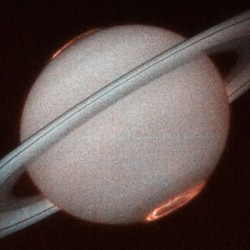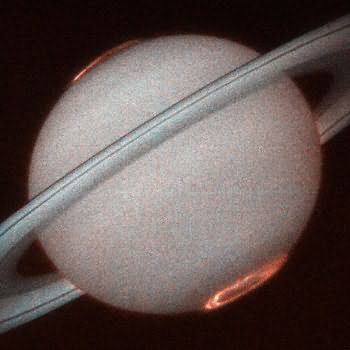An infrared camera aboard NASA’s Cassini spacecraft has discovered a unique aurora lighting up Saturn’s polar cap. The mysterious new aurora is unlike any other known in our solar system. “We’ve never seen an aurora like this elsewhere,” said Tom Stallard, an RCUK Academic Fellow working with Cassini data at the University of Leicester. Stallard is lead author of a paper released today (13th
November) in the journal Nature. “It’s not just a ring of aurorae like those we’ve seen at Jupiter or Earth. This one covers an enormous area across the pole. Our current ideas on what forms Saturn’s aurorae predict that this region should be empty, so finding such a bright one here is a fantastic surprise.”
Aurorae are caused when charged particles stream along the magnetic field of a planet and into its atmosphere. On Earth these charged particles come from the solar wind – a stream of particles that
emanates from the Sun.
Jupiter’s main auroral ring, caused by interactions internal to Jupiter’s magnetic environment, is constant in size. Saturn’s main aurora, which is caused by the solar wind, changes size dramatically as the wind varies. The newly observed aurora at Saturn, however, doesn’t fit into either category.
“Saturn’s unique auroral features are telling us there is something special and unforeseen about this planet’s magnetosphere and the way it interacts with the solar wind and the planet’s atmosphere,” said
Nick Achilleos, Cassini scientist on the Cassini magnetometer team at the University College London. “Trying to explain its origin will no doubt lead us to physics which uniquely operates in the environment of Saturn.”

The new infrared aurora appears in a region hidden from NASA’s Hubble Space Telescope, which has provided views of Saturn’s ultraviolet aurora. Cassini observed it when the spacecraft flew near Saturn’s polar region. In infrared light, the aurora sometimes fills the region from around 82 degrees north all the way over the pole. This new aurora is also constantly changing, even disappearing within a 45 minute-period.
Source: NASA


Might just be that picture but it lines up with the hexagon remarkably well!
It does look peculiar. I always wondered if aliens were “hanging out” on the other planets of the solar system. Only time will tell…
Completely amazing stuff. It seems almost daily new and totally unexpected things are discovered.
It shows in infrared only or does it have a signature n other wavelengths?
Saturn doesn’t have enough mass to become a star.
Very cool and unusual story and pictures. That hexagonal feature has always puzzled me, too.
Why wouldn’t the infrared and ultraviolet aurorae be two different signatures of the same aurora ?
Mathieu Clerte asks:
“Why wouldn’t the infrared and ultraviolet aurorae be two different signatures of the same aurora ?”
if I follow it correctly:
one of them changes predictably a the Solar Wind changes.
the other changes unpredictably
Maybe Saturn the giant gaseous planet wants to become a new star and is igniting, it large enough.
Wow, more magical photography. Thanks
The correspondence of the infrared aurora and the hexagon indicates, one may suspect, a connection between the two. Auroras are the photon emissions of plasma/electron currents (a finding supported by the recent Cluster satellites in Earth orbit), so it’s reasonable to conjecture that the hexagon is an electrically induced phenomenon.
I just finished reading an article about thermodynamics in Scientific American. It seems that, if you have a thin fluid layer and heat it from the bottom, a strange thing happens. As the temperature gradient across the layer increases it begins to move. Not chaotically, as you might expect, but quite orderly. In fact, the fluid will form small hexagonal cells as though it were a crystal!
Only continued heating will produce turbulence. Is it possible that the observed hexagon pattern on Saturn is somehow related to this phenomenon? If it’s not, it sure is a heck of a coincidence!
I imagine there is a lot of heat in Saturn’s interior. That could be the heat source fot the scenarios you mentioned.